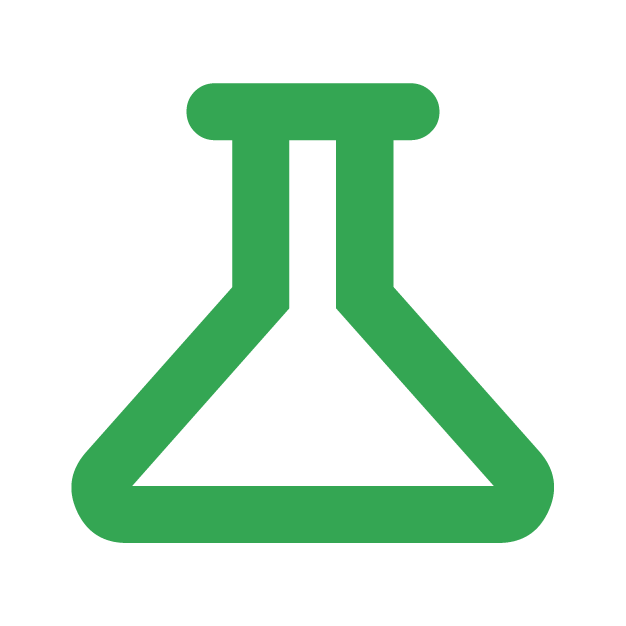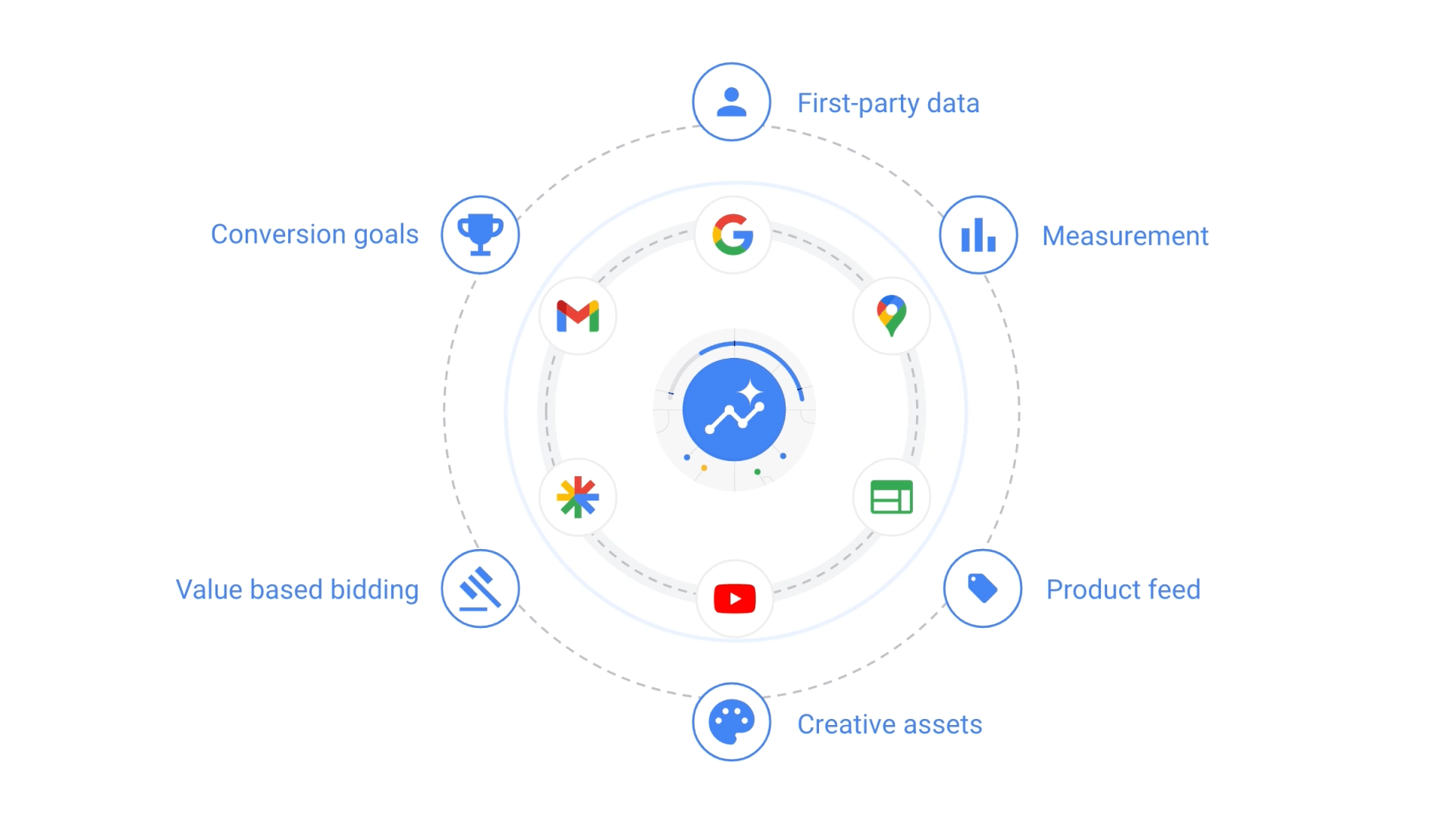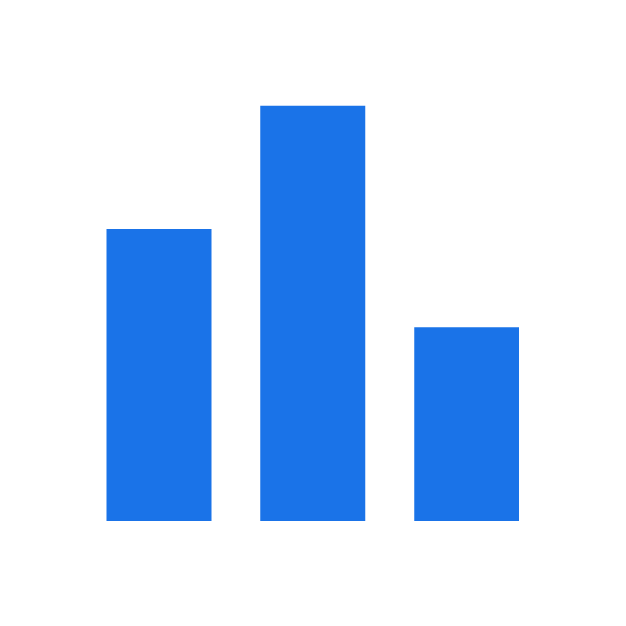
Who is this guide for?
We’ve created these best practices for retail marketers who are running Performance Max campaigns with a Google Merchant Center feed. If your goal is to increase sales and reach new customers, these guidelines will help you get there.
Consumers have never had more options—more ways to get inspired, to research, or to buy. During the 2022 holiday season, 55% of shoppers used five or more channels, ranging from video to social media, to shop over a two-day period.1 AI enables businesses to respond to dynamic shifts in consumer demand in real time, and to present valuable customers with the most relevant ads possible as they toggle among channels.
For a growing number of retail marketers, Performance Max has become a critical solution to meet customers wherever they're shopping. Powered by Google AI, Performance Max helps retailers increase sales and optimize ROI across all Google Ads channels and inventory—including Search, YouTube, Display, Discover, and Google Maps.
With Performance Max, Shopping ads and local inventory ads remain important formats that are shown in Google Search and Shopping results. Performance Max also builds on this to help you reach more valuable customers and drive more conversions from additional channels and inventory. And we’ve made it easy for you to measure the incremental impact of shifting from Standard Shopping campaigns to Performance Max.
 |
Will Performance Max outperform your Standard Shopping campaigns? Run an experiment to be sure. |
| |
Advertisers that have shifted from Standard Shopping campaigns to Performance Max drove a 25% increase in conversion value, on average, at a similar ROAS.2 And you can test this for yourself!
If you are running Standard Shopping campaigns, you can run an experiment in order to measure the uplift in conversion value from switching to Performance Max. With new one-click experiments, it’s now easier than ever to set up an A/B test that will automatically create a new Performance Max campaign from an existing Standard Shopping campaign.
If you’re satisfied with the results of your A/B experiment, you can then continue running your new Performance Max campaign to replace your Standard Shopping campaign.
|
Performance Max campaigns are goal-based and can be configured to optimize towards online sales, store sales, or omnichannel sales. By providing your goals and other inputs, you can combine your marketing expertise with the power of Google AI to maximize profitable sales.

This guide offers step-by-step guidance in the following areas:
|
 |
Lay the foundation for your Performance Max campaign
Enhance your product feed to help your ads stand out.
- Upload rich product descriptions and images, and update product prices and availability if they change often.
- Ensure listed products are approved and use the Product Issues column to identify missing feed attributes or spot underperforming offers.
- Add a local product feed to automatically enable local inventory ads in your campaigns to promote products and promotions available in stores.
- You can also use your feed to attract consumer attention to your ads with deals by creating promotions or price drop annotations. Set up free and fast shipping annotations to show you can ship quickly, and use return annotations to highlight return windows like “Free 90-day returns”.
- Consider including custom labels in your feed to signal that a product is high-priority—for example: “bestseller,” “trending,” or “holiday product”. You can then use the labels to segment these products into separate campaigns or asset groups if needed.
Lay the groundwork for strong measurement to unlock business growth.
- Establish robust sitewide tagging with the Google tag to capture the data that matters most to you.
- Set up enhanced conversions to improve the accuracy of your conversion measurement and unlock more powerful bidding.
- Assign a store visit value or use store sales values to measure the full purchase journey and optimize your campaign to drive more purchases in stores. You can also create custom variables for store sales to access more granular reporting by customer segment or product category, for example.
- If you have an app, create a seamless web-to-app experience and improve campaign performance with Web to App Connect. You can set up deep links to send users directly to a relevant, in-app page when they click on your ads on the mobile web. You’ll also be able to set up in-app conversion measurement and bidding to measure in-app actions such as purchases and sign ups, and to optimize your campaign performance.
Case Study
“Given the rise in app usage, it was essential to track and optimize our in-app conversions for our web campaigns. We used Web to App Connect to ensure the best ad experience for customers that already have our app. After implementing Web to App Connect, we saw a 2x conversion increase and 48% average-order-value increase when customers landed in-app instead of the mobile site. This holistic bidding strategy also improved overall campaign performance, with a 68% ROAS uplift for our Performance Max campaigns.”
— Marc Mulder, Head of Search, de Bijenkorf
Share conversion values for better optimization and reporting.
- When you use conversion tracking, you can assign the same value to all conversions or let each conversion have different values. For retailers, we strongly recommend providing transaction-specific values for each conversion if your customers are purchasing items with different prices and you want to maximize total revenue.
- Use conversion value rules to provide additional value information that further refines your optimization. Set values for lower or higher-value types of customers, devices, locations, store visits or store sales.
|
|
 |
Plan budgets early, but be ready to capture additional sales opportunities
Use Performance Planner to identify budget and bid strategies that will maximize conversion value.
- Use Performance Planner to review your campaign’s projected monthly and quarterly performance. Get suggestions that can help your campaigns perform better for the same spend, and find out how your spend and performance are affected if you change your budget or bid targets.
- Performance Planner’s forecasts are also adjusted for seasonal events so you can explore conversion opportunities during key moments like holiday.
Proof Point
Budget agile marketers are 25% more likely than non-agile marketers to report their performance as stronger than industry competitors.3
Explore demand forecasts to take advantage of increased demand.
- Demand forecasts can help you to understand predicted upcoming trends relevant to your business, so you can plan budgeting and bidding strategies accordingly.
- Review when demand is likely to start increasing: You may already know events that are important to your business, such as Black Friday. See how demand is forecasted to increase for the products and services related to these major seasonal events.
- Identify new events relevant to your business: There may be less well-known events that increase the demand for your products and services. Review these and consider adjusting your campaigns to capture that demand.
Check recommendations for tips on budgeting, bidding, and more.
- View your optimization score to see where your campaign has room to grow. The higher your score, the more optimized your campaign is. Also check your recommendations for suggestions on how to improve your campaign.
- For example, you may see a recommendation to raise or re-distribute your budgets for upcoming traffic increases when our simulations show that you could miss out on potential customers or that your ads may even stop running on your busiest days.
- You can also find and apply other types of recommendations to improve your campaign, such as optimizing for new customer acquisition.
Use seasonality adjustments to optimize for short promotional or other events.
- If you expect a large change in conversion rates over a short period of time, you can use seasonality adjustments to prepare. Seasonality adjustments are a great tool for short, infrequent events, where you expect a significant change (e.g. >30%) in conversion rates over a narrow time window (<7 days). Examples might include a three-day mega sale or Black Friday weekend.
- Because conversion history is required, seasonal adjustments should only be used on existing campaigns.
- If you are running a longer promotion or expect a smaller conversion rate change, we recommend manually adjusting ROAS or CPA targets to help Smart Bidding accommodate the seasonality.
|
|

|
Structure your campaigns for success
Consolidate your campaign structure to help Google AI learn and optimize faster.
- When setting up a new Performance Max campaign, you should consolidate your campaign structure where you can. Google AI works best when it can optimize performance across channels using a unified budget.
When to create multiple campaigns.
- Sometimes, it does make sense to manage separate Performance Max campaigns. For example, you may have campaigns for different countries and/or languages. Or, you may have different budgets or ROAS targets for new products, top-selling products, seasonal moments, or different store locations.
- During the holiday season, you may want to prioritize certain types of products, and create separate Performance Max campaigns for those items.
- For example, you may want a campaign for holiday merchandise, a campaign for high-margin products, and a campaign for everything else. Setting a lower ROAS target can also help maximize visibility for these products in the weeks leading up to peak periods when many people are browsing.
When to use asset groups to segment a single campaign.
- Create multiple asset groups within the same campaign to bundle assets that should serve in sets or themes (e.g. different asset groups for dinner plates vs. bowls).
- You may also want to create multiple asset groups if certain assets are more relevant to specific audience signals that you’ve inputted. For example, you may want different assets for a Customer Match list, such as customers who bought bikes and you now want to cross-sell bike helmets.
- During the holidays, we recommend creating new holiday-specific asset groups within existing campaigns. This ensures you avoid disrupting your evergreen products and helps optimize holiday performance. New holiday assets and asset groups should be uploaded at least 2 weeks in advance to make sure they're approved.
- Use asset group scheduling to activate the holiday or seasonal asset groups at a specific time. For example, you could schedule a new set of holiday-themed assets ahead of a special sitewide sale or promotion.
|
|

|
Provide essential inputs to guide Google AI to deliver stronger results
Implement a value-based bidding strategy to drive more performance for your budget.
- After you set values for your conversions, apply a value-based bidding strategy aligned with your business objectives. Use Maximize conversion value bidding to help Google AI maximize the total conversion value of your campaign within your specified daily budget.
- For better results, set a ROAS target based on what will yield the highest profit. Consider cost of goods sold and customer lifetime value.
Reach new customers with the new customer acquisition goal.
- Use the new customer acquisition goal to maximize revenue while driving more new customers to your business.
- Choose the New Customer Value mode to optimize your campaign to prioritize and bid higher for new customers, while still maximizing sales from existing customers.
- New Customer Acquisition with High Value optimization is also now available in beta to help you optimize for new customers with high predicted lifetime value, while still optimizing for regular new customers and engaging existing customers. Reach out to your Google account team for more information.
- Choose New Customer Only mode to optimize to only new customers. With this mode, you might miss out on sales from returning customers who might not have otherwise purchased without engaging with your ad. It makes sense to choose this mode in some cases, such as when you have a specific budget dedicated to new customer acquisition.
- Provide as many data sources as possible to accurately detect whether someone is a new or repeat customer. Share your own definition of a new customer with website tagging (Global Site Tag and new customer parameters), provide a first-party customer list of existing customers via Customer Match, and opt in to Conversion-Based Customer Lists.
Case Study
Hairstory is a growing US-based hair care retailer revolutionizing the industry by imagining a future without shampoo. Working with its agency Better & Stronger, Hairstory was excited to try new customer acquisition goals with Performance Max to reach its objectives. Hairstory was able to reach more high-value customers, which helped it increase return on ad spend (ROAS) by 31%. Additionally, it achieved its objective of increasing conversions from new customers, driving a 545% increase in new customers converted.
“Once someone tries our products, we have a very strong retention rate. Our main challenge is driving that initial customer acquisition. With this objective, we focused on new customer acquisition for Search and Performance Max. We’re seeing great results so far.”
— Karthik Paramasivam, Head of Marketing, Hairstory
Reach the right audiences by leveraging first-party data.
- Add audience signals that will help Google AI find relevant customers and drive more conversions.
- Your consented first-party data from previous purchasers shared via Customer Match is the most valuable type of audience signal. Custom segments are another useful audience signal to provide insight into the search terms, website URLs, and apps your customers typically engage with.
- Refresh these lists frequently to ensure your campaign makes optimization decisions based on up-to-date information.
Diversify and maximize your creatives to resonate with more customers across channels.
- If you have online sales goals, your product feed will be used as a starting point to create and show your ads. We strongly recommend that you also add a variety of text, image and video assets and refresh them regularly. This allows your Performance Max campaign to serve across more eligible inventory so you can achieve the best results possible.
- If you’re optimizing to store goals, you must include the full range of creative assets: text headlines, descriptions, images, logos, video, calls-to-action, business name and a final URL.
- To make it easier to provide high-quality video ads, video creation tools are now integrated directly into Performance Max campaign setup and editing workflows.
- Note: If you do not provide your own video creative, then one or more videos may be auto-generated to help you drive more conversions from this inventory. These videos draw from your existing text assets, images, and product feed to maximize video quality and relevance.
Proof Point
Advertisers that included at least one video in their Performance Max campaigns saw an average increase of 12% in total conversions.4
Enable automatically created assets and final URL expansion to drive more sales from Search.
- First, keep the automatically created assets feature enabled to generate more relevant headlines and descriptions so they’re more tailored to a user’s search.
- Then, keep final URL expansion turned on. Final URL expansion helps you find new, converting search queries, and replaces your final URL with another landing page on your website that better matches a user’s intent. Final URL expansion also gives automatically created assets more landing page options to draw from to help you build more diverse and relevant assets.
- If you need to apply exclusions to final URL expansion, you can use URL exclusions or URL parameter rules, account-level negative keywords, and campaign-level brand exclusions.
- Note: Final URL expansion is not available to campaigns that only optimize to store goals.
Proof Point
Advertisers who use final URL expansion with Performance Max campaigns see an average increase of over 9% in conversions or conversion value at a similar CPA or ROAS.5
|
|

|
Use reporting and insights to evaluate your results
Understand changes in performance.
- With improved asset group reporting, you can see conversions, conversion value, cost, and a variety of other metrics at the asset group level. Discover how different asset groups influence performance and where you should prioritize improvements like adding creative assets or optimizing existing assets.
- Use explanations to examine performance fluctuations. Explanations convey the “why” behind significant performance changes and recommend actions to fix issues and improve performance.
- Top signals in your bid strategy report are another helpful way to see what factors influence your performance. Top signals may include, but are not limited to: device type, location, day of week, time of day, search queries, and Customer Match lists.
- Check out performance shifts insights to see which assets groups, products, and product types are driving performance changes.
See which creative assets are resonating.
- Use Ad Strength to see if your asset quality is “low,” “good,” or “best,” and whether you need to add new assets for Google AI to use in your creative. If you already have the maximum number of assets, you can swap out your lower-quality ones for new, higher-quality assets.
- Understand your top-performing asset combinations for each asset group with the Combinations report. This report also helps you visualize how your different text, image and video assets are used in a variety of ad formats.
- Explore asset audience insights to see which assets resonate most with different audience segments. Use this to inform how you generate new creative assets to attract high-performing audiences.
Understand your top customers and uncover new audiences.
- Check out audience insights to understand top interests and behaviors of the customers who convert from your Performance Max campaigns and to see which audiences convert at higher rates.
- Understand conversion data for segments you inputted as audience signals by looking at segments with a 'Signals' label. Focus on segments labeled as 'Optimized' to learn the new audience segments Google AI helped discover that you may not have known about previously.
Explore how your customers are searching.
- Use search terms insights to understand your customers’ search queries, organized into categories. Now, you can even apply custom date ranges so you can view your historical insights.
- Examine search trends to see if you’re keeping up with increased demand in categories that are relevant to your business. Use these insights to plan budgets, inventory, promotions, and landing pages based on trending customer search interest.
Analyze retail-centric reports.
- Use product insights on the Products page in Google Ads to identify product-level optimization opportunities based on market potential, and apply changes more easily with actionable recommendations. With the diagnostics tab, you can also uncover and fix issues that may be impacting the performance of individual products.
- With category insights on the Products page in Google Ads, you can see which product categories are trending, with the ability to adjust the granularity of the categories and subcategories that you’re viewing.
- View your most popular products in the best sellers report in Google Merchant Center. You can use this report to understand demand for brands and products, and prioritize which products to show in advertising campaigns.
- Use the price competitiveness report in Google Merchant Center to analyze how competitors are pricing similar products by category, country, and brand. Use this information to improve your pricing and bidding strategies on top products.
|
1. Source: Google/Ipsos, Holiday Shopping Study, Oct 13 2022 – Jan 4 2023, Online survey, US, n=8,467, Americans 18+ who conducted holiday shopping activities in past two days.
2. Google Data, Global, Ads, October 2022 - March 2023.
3. Google/Kantar Budget Agility and Channel Desiloing Research, US, CA, AU, BR, DE, IN, JP, UK, March 2022 - June 2022. Advertiser: Agile n=416, Not Agile n=1677.
4. Google data, Global, November 2022.
5. Google Data, Global Ads, February - April 2023.